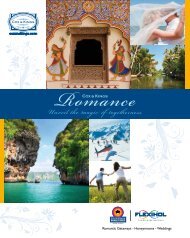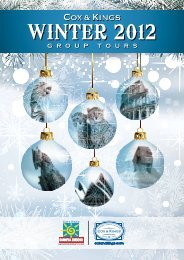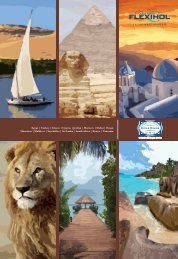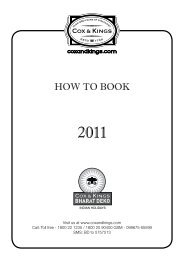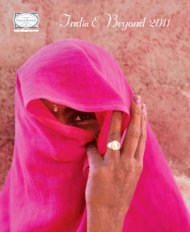Download PDF - Cox & Kings
Download PDF - Cox & Kings
Download PDF - Cox & Kings
- No tags were found...
You also want an ePaper? Increase the reach of your titles
YUMPU automatically turns print PDFs into web optimized ePapers that Google loves.
Luxury EscapadesAsia & The Pacific FactfileVIETNAMCapital: HanoiPopulation: 86.9 millionCurrency: Dông (VND)Official Language(s): VietnameseVietnam is a colorful and diverse country from thewild mountainous north with its myriad of ethniccommunities to the steamy city of Saigon on the edgeof the Mekong Delta. The charming capital Hanoiis a fascinating mix of fading colonial buildings andnational monuments and the spellbinding sceneryof Halong Bay is now a World Heritage Site. Hueoffers an insight into the Imperial days, while thebeachside port of Hoi An has an intriguing blend ofJapanese, Chinese and European influences.What To SeeVietnam is a fascinating country of buzzing cities,historic towns, and the magnificent Mekong Delta.Highlights of this region include the fascinatingcities of Hanoi and Saigon, the historic pearls ofHué and Hoi An, the Cu Chi Tunnels and themagnificent landscape of Mai Chau, Halong Bayand the Mekong Delta.Halong Bay: Situated in the North-East region ofVietnam, Halong Bay is a bay in the Gulf of Tonkincomprising the regions of Halong City, the townshipof Cam Pha, and a part of the island district of VanDon. There are two kinds of islands, limestone andschist, which are concentrated in two main zones:the southeast and the southwest (belonging toHalong Bay). This densely concentrated zone ofstone islands, famous for its spectacular sceneryof grottoes and caves, forms the central zone ofHalong Bay, which has been named a UNESCOWorld Heritage Site.The Mekong Delta is Vietnam’s ‘rice bowl’ a fertileregion of flat farmland interlaced with thousands ofwaterways and tributaries of the Mekong, knownlocally as Cuu Long, the river of Nine Dragons.The Delta’s waters are interspersed with ricefields, colourful floating markets, isolated villagesand accessed only by boat. Annexed by Cambodiaby the invading Vietnamese in the 17th century,the region remains home to descendants of theformer Khmer Empire and the region is scatteredwith a working collection of temples and residentBuddhists that continue to use Khmer as theirmother tongue.www.coxandkings.comWhen To GoVietnam’s temperatures and rainfall vary widely.However, the best overall months are probablyOctober to March. The rainy season for most ofthe country is between May and September.LAOSCapital: VientianePopulation: 6.3 millionCurrency: The Kip (LAK)Official Language(s): Lao, FrenchLand-locked by Cambodia, China, Myanmar,Thailand and Vietnam, Laos covers an area roughlythe size of Great Britain much of which is dominatedby mountains and rivers. For many years Laoshas lay over-shadowed by its neighbours, causingmuch of it to remain undeveloped. Local culture isbased on Theravada Buddhism that makes Laos apeaceful destination to travel within, but also lendsits people a unique charm and friendliness.What To SeeNo trip to Laos would be complete without astay in the peaceful town of Luang Prabang. Bestknown for its high concentration of Buddhisttemples and serene location on the banks ofMekong, Luang Prabang was declared a UNESCOWorld Heritage site. The river Mekong runs fromthe north-west to the most southern tip of Laos,forming a natural border with Thailand. You couldspend several days cruising the river, providing agreat opportunity to see some of the more remoteareas of the country, which are often inaccessibleby road. The Plain of Jars in the north is also aninteresting sight, the landscape being dotted withhundreds of mysterious and centuries-old stone jars.When To GoGenerally speaking, the best time to visit Laos isbetween November and March. During this timethe country experiences the least amount ofrainfall without becoming too hot.CAMBODIACapital: Phnom PenhPopulation: 2 millionCurrency: The RielOfficial Language(s): Khmer, Chinese, VietnameseCambodia is home to the temples of Angkor,the magnificent legacy of the Khmer empire thatruled over much of Southeast Asia 1,000 yearsago. The centerpiece is Angkor Wat, the world’slargest religious monument and one of the FarEast’s must see sites.What To SeeSiem Reap is a cluster of villages with a Frenchcolonial center, and the gateway to the Templesof Angkor. The capital city Phnom Penh enjoys adelightful setting on the confluence of three rivers,and is an interesting mix of colonial buildings,temples, markets and broad avenues.When To GoThe rainy season falls between late April andSeptember. The best time of year to visit is duringthe cooler and drier winter months betweenNovember and March.MYANMARCapital: RangoonPopulation: 47.4 millionCurrency: KyatOfficial Language(s): BurmeseBurma, or Myanmar, is one of most fascinatingdestinations in the Far East, untouched by masstourism as a result of decades of isolation imposedby its military dictatorship. It is a culturally richland with a long history and a diverse ethnic mix.What To SeeHighlights include the majestic Shwedagon Pagodain Rangoon, the majestic temples and pagodas inancient Pagan, the monasteries of Mandalay andthe beautiful Inle Lake, famous for its floatingvillages and gardens and the leg-rowers of the Inthatribe. Ngapali Beach on the Bay of Bengal is anideal place to relax and rejuvenate after the tour.When To GoThe best time to travel to Burma is fromNovember to February, during the country’s dryseason, when the weather is also not too hot. Itcan get very hot between March and May, and themonsoon peaks between July and September.Note: We have chosen to work with local partnersand who support projects that help local communitiesin Burma and promote sustainable development. ByAsia & Pacific 2011 I 121




